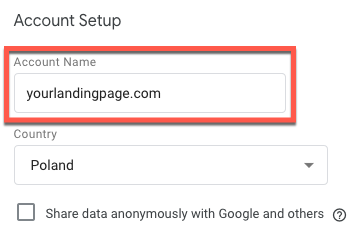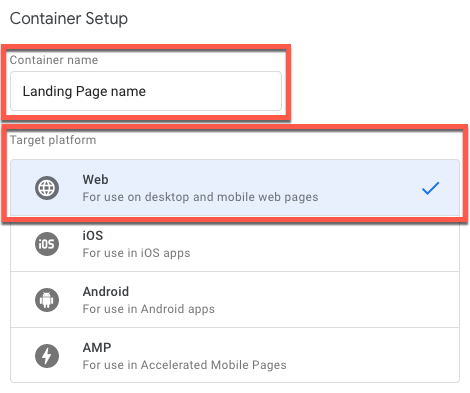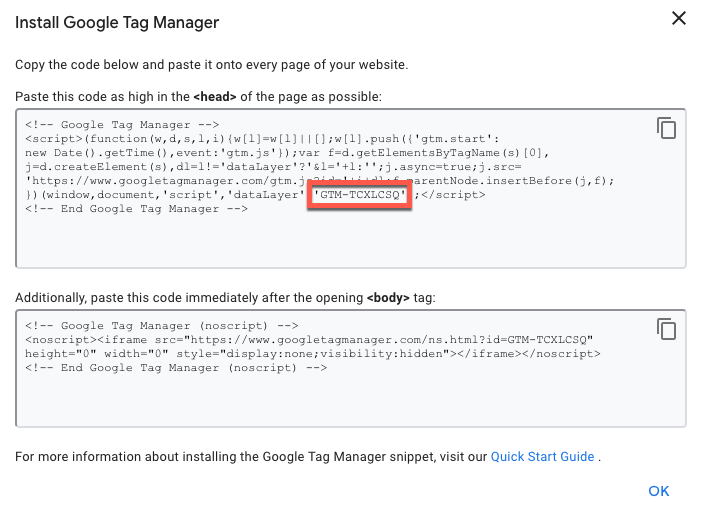How to integrate my landing page with Google Tag Manager?
Before you begin
You will need an active Google Tag Manager account.
- If you have a Google Tag Manager account, you can automatically enable a container on your GetResponse landing pages.
- If you don’t have a Google Tag Manager account, simply create a new one.
How do I prepare the integration ID in Google?
If you already have a Google Tag Manager account, enter your container ID in the landing page settings.
You can find your container ID by clicking Accounts in the top menu. You’ll see the list of your accounts. Copy the code from the Container ID column.

How to create a Google Tag Manager account?
- Go to sign up. Follow the on-screen instructions during setup.
You can use your existing Google account. When you do, you’re instantly directed to the Google Tag Manager setup. - Set up the account name and click Continue.

- Add a container name. You can, for example, use your landing page name to identify the account easily.
- Choose Web as the choice for Where to Use Container and click Create.

- Accept Google Tag Manager Terms of Service Agreement.
- You’ll see a Google Tag Manager container code with a container ID. Select the container ID and copy and paste it into the landing page settings.

- When you click OK, you will land on the Google Tag Manager dashboard.
You can now create your first tag. If you’re unsure where to start, see Tag Manager Help. - Select your container ID and copy it. You’ll need the code in the following steps.

How do I include the tracking code on my landing page?
To add the Google Analytics tracking code to your landing page:
- Log into your GetResponse account and create a new page or chose an existing one.
Learn more about creating a landing page here. - Go to Landing pages > Click on the Actions icon (vertical ellipsis) > Edit settings > Analytics and integrations section.
- Select Google Tag Manager from the list and enter your Google Tag Manager ID using the format: GTM-12X34Y.

- Click on the Save settings button.
You can now add predefined tags in Google Tag Manager. The tag manager works with Google Analytics, Google AdWords, AdRoll, LinkedIn, and many others.
Note that to benefit from the Tag Manager integration, you need to enable one or more tools.
For example, you will be able to use Google Analytics, as described here.
What is Google Tag Manager and how does it help in landing page tracking?
Google Tag Manager is a free tool that helps you skip tedious code-editing tasks on your landing page. You or your team members can manage tracking codes in one place.
You don’t have to modify landing page code to use Tag Manager.
For more advanced uses, you can add your own tags. Such custom tags include, as examples, JavaScript snippets for conversion tracking, site analytics, or remarketing.
They can do all the work for you, leaving you time to relax and focus on other important work.
Learn more about Google Tag Manager.
Pro tip: We send addition ‘Lead‘ event in dataLayer object for every subscription.
Thanks to this, you can send the data to all platforms you’ve added in Google Tag Manager, for example Facebook, Google AdWords and many more.
Steps for legacy landing pages
To add the Google Analytics tracking code to your legacy landing page:
- Log into your GetResponse account and do one of the following:
- Create a new landing page.
- Edit the settings for an existing landing page.
- When you’re happy with your landing page layout, click Next step and proceed to My landing page settings.
- Scroll down and expand the Analytics & remarketing section.
- Select Google Tag Managerfrom the list and enter your Google Tag Manager ID using the format: GTM-12X34Y.

- Click Save if you edited an existing landing page or Publish if you created a new one.




